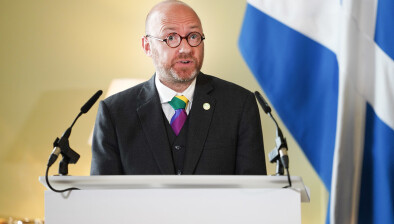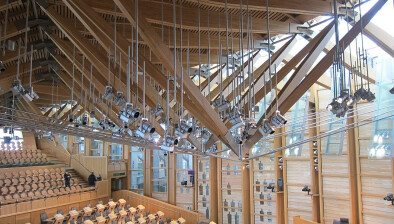Homelessness pilots welcomed but Programme for Government ‘fails to tackle housing emergency’

Stronger protections for tenants, helping deliver more affordable homes, and removing barriers on stalled building sites were all on the agenda for First Minister John Swinney as he set out his government’s legislative programme at Holyrood yesterday, although sector bodies have warned the measures don’t go far enough to tackle the ongoing housing emergency.
In the Programme for Government 2025-26, the Scottish Government said it “will deliver 110,000 affordable homes by 2032, leveraging in further private and social sector investment to create a total package of around £20 billion, supporting between 12,000 and 14,000 jobs each year”.
Backed by increased investment of £768 million, and implementing the recommendations of the Housing Investment Taskforce to unlock new investment opportunities across all tenures, the government said it will ensure more people can access good, affordable, homes by a series of measures including:
- Delivering over 8,000 affordable homes for social rent, mid-market rent and low-cost home ownership, with a focus on acquisitions and family-sized homes.
- Removing barriers on stalled housing sites to deliver up to 20,000 new homes.
- Driving down numbers of privately owned long-term empty homes, by investing £2m through the Scottish Empty Homes Partnership.
- More than doubling the budget – from £8.25m to almost £21m – to deliver around 8,500 general housing adaptations to disabled tenants, so they can live independently in their home.
- Supporting the completion of the six Gypsy/Traveller site demonstration projects funded by the Gypsy/Traveller Accommodation Fund.
- Delivering more affordable homes in rural and island communities by extending the Rural and Island Housing Fund to new applications to March 2028.
- Delivering an equivalent of Awaab’s Law in Scotland – ensuring landlords promptly address issues that are hazardous to tenants’ health. Subject to the passage of the new Housing (Scotland) Bill, the government will bring forward secondary legislation to develop timescales for investigation and commencement of repairs that are hazardous to tenants’ enjoyment of their homes, starting with damp and mould.
- Tackling homelessness by implementing the new Housing (Scotland) Bill which, if passed, will improve outcomes for those at risk of homelessness and strengthen tenants’ rights, including through the introduction of a system for longer term rent controls, and removing the legislative constraint on the level of council tax premium that can be applied to second and long-term empty homes.
- Investing £1m in a fund administered by the Scottish Federation of Housing Associations and Homeless Network Scotland, bringing together registered social landlords, third sector organisations and community partners to prevent homelessness and protect tenants’ rights.
- Investing £4m in homelessness prevention pilots in 2025-26, helping duty bearers to prepare for the new legislation and to implement the ‘ask and act’ duties effectively.
Legislative programme
In its Year 5 programme, the Scottish Government intends to introduce the Heat in Building Bill, while the Building Safety Levy from Year 4 will be introduced before the summer recess.
Bills currently in Parliament include Community Wealth Building, Housing and Land Reform.
For the Scottish Federation of Housing Associations (SFHA), the First Minister was right to acknowledge the concern of people unable to find affordable housing, but the Programme for Government failed to implement the bold action required to deliver this.
SFHA chief executive Sally Thomas said: “With nearly a quarter of a million people across Scotland currently on a waiting list for a social home, and a housing emergency declared almost a year ago, it was vital that (yesterday’s) Programme for Government set out coherent action to increase the provision of affordable rented homes. The measures announced today are welcome, but don’t go far enough to tackle Scotland’s dire situation on housing.
“A decent, stable home is the foundation of the fairer, greener and more prosperous Scotland the First Minister wants to build. So we are glad to see continued ambition to build 110,000 affordable homes by 2032. But for this to have any chance of becoming a reality, the Scottish Government must quickly set out multi-year funding commitments, so that our members can plan with confidence to build much-needed homes.
“We are disappointed that there is still no commitment to exempt Mid Market Rent homes from private rented sector rent controls. This type of housing is highly valued by younger people and professionals in particular, but it may become unviable unless the government amends the Housing Bill.
“It is reassuring to see commitment to a Heat in Buildings Bill. But we need certainty on the targets our members will need to meet, as well as a fair and equal approach to the standards required of every housing tenure, including home ownership and private rent. And we had urged government to provide a clear pathway to funding on removing unsafe cladding: we can’t allow this burden to fall on social tenants.
“A warm, secure, affordable home is the foundation of all our lives, and while this Programme for Government recognises that, there is an urgent need for quicker, bolder action if we are to end the national housing emergency.”
Sector body Homes for Scotland (HFS) expressed disappointment at the lack of prominence, urgent interventionism and detail relating to housing delivery.
HFS chief executive Jane Wood said: “There are some encouraging elements in the 2025/26 Programme for Government, including the commitment to make it easier to invest and do business in Scotland by ensuring future regulation is scrutinised for its impact on business and investment, and the assessment of regulatory controls in housing by the end of 2025. Much more is required, however, given the sheer scale of the challenge that faces our country.
“It has nearly been a year since the Scottish Parliament declared a national housing emergency and in the interim we have seen record numbers of children living in temporary accommodation, all sector starts and completions continue to fall and absolutely no support for our struggling SME home builders (who are so crucial to increasing the supply of high quality energy efficient homes in rural areas and on brownfield sites) despite our extensive work to produce recommendations for the Scottish Government to take forward.
“The recommendations of the Housing Investment Taskforce are still yet to be published and we still do not have any clearly defined operational status regarding the much-vaunted Planning Hub. Calls for an annual all-tenure target for the delivery of 25,000 homes made by a range of charities and business organisations over the last week or so have also gone unheeded.
“We needed so much more from (yesterday’s) announcement.
“Yesterday, we needed a bold interventionist approach to increase housing delivery across all tenures in Scotland. Unfortunately, the housing emergency remains without an emergency response, with the Scottish Government missing a clear opportunity to reset the scale of its ambition on housing and ensure both national and local policy is shaped to tackle the housing emergency head on.
“Home builders are waiting to play their part in delivering Scotland’s all-tenure housing but it feels that we are in a landscape where the government seems unable or unwilling to fully acknowledge just how important housing is to Scotland’s social wellbeing and economic success.”
The disappointment at the lack of crucial detail about how the Scottish Government plans to tackle the housing emergency was echoed by Shelter Scotland.
Director Alison Watson said: “While we welcome the continuation of the plans which have already been announced, this is simply not enough. We are coming up to a year since a national housing emergency was declared. The situation is deteriorating across the country with a record high number of children trapped in temporary accommodation. There are still no significant increases in plans for social home building, extra budgets or investment in housing services to prevent more people becoming homeless.
“Shelter Scotland wanted a programme for secure homes, but all we have is a programme for homelessness.”
Timothy Douglas, head of policy and campaigns at Propertymark, added: “The Scottish Government’s Programme for Government comes at an important juncture with the unresolved housing emergency and Holyrood elections in 12 months’ time. Implementing the recommendations of the Housing Investment Taskforce and allowing more properties to be exempt from rent control areas are welcome.
“However, to truly bring down the cost of renting and get more people on the housing ladder as well as make it easier for people to buy and sell their homes, the Scottish Government must urgently review all costs and taxes impacting private landlords, reduce the Additional Dwelling Supplement and revise the bands and reduce the rates for Land and Buildings Transaction Tax. These are powers held by Scottish Ministers and action must be taken.”
Ask and act pilots
New plans, worth £4m, to test out how different public services can work together to best prevent people from becoming homeless, ahead of the Housing Bill being passed into law, have been welcomed by Crisis.
Announced in the Programme for Government, the Scottish Government confirmed it will run a series of pilots to test how new laws, aimed at preventing homelessness, could work in practice.
The announcement follows calls from Crisis, ahead of the latest budget, for the government to commit funding to pilot new duties that will come into force in the next Parliamentary term, provided the Housing Bill passes.
The Housing Bill, currently at Stage Two in the Scottish Parliament, contains new measures to allow people at risk of homelessness to get help much earlier on, and to introduce new legal ‘ask’ and ‘act’ duties across public services, which will widen responsibility for homelessness prevention. These new laws were recommendations from the homelessness charity, and directly from experts who have lived experience of homelessness.
But while Crisis said the new plans to prevent homelessness could help Scotland create a world-leading homelessness system, it has also highlighted that changing the law will not by itself lead to the systems change needed. Crisis welcomes ministers’ commitment to run a series of pilots as part of this Programme for Government to ensure the new measures are effective in practice. The pilots will run from 2025-2026.
Maeve McGoldrick, head of policy and communications for Crisis Scotland, said: “Scotland is in the grip of a housing emergency. That means more people trapped in emergency accommodation, more people experiencing the pain and indignity of homelessness, and more children forced to grow up without a safe, secure home.
“New plans in the Housing Bill to stop homelessness from happening in the first place could help turn the housing emergency around and allow Scotland to create a truly progressive homelessness system. These new protections represent a world-first, but it is vital we do all we can to pilot them now, ahead of national rollout.
“Introducing new legal duties to different public services will only be a success if the government gets the design and delivery right. The pilots must show how they can work in practice, how much they will cost, and what’s needed to make them a success. Crucially, the pilots should help the government come to understand the true potential of meaningful homelessness prevention services in Scotland. Learning which ought to be taken into the next parliamentary term.
“We strongly welcome the government’s announcement in today’s Programme for Government to pilot this work. By testing out the new protections ahead of their introduction, we can help build a Scotland where everyone has a safe, secure place to call home.”
Programme for Government recognises value of planning
The Programme for Government’s plans to boost planning capacity and reduce barriers to delivery could be a positive step forward, according to the Royal Town Planning Institute (RTPI), but only if approached collaboratively, transparently, and built on a robust evidence base.
Dr Caroline Brown, director of RTPI Scotland, said: “When properly resourced, planning provides the foundation for delivering the country’s wider priorities. The Government’s recognition that planning must be at the heart of its economic growth strategy is a welcome and overdue understanding of its value.
“For too long, the planning system has been undervalued and underfunded. Measures outlined in the Programme for Government mark a positive step toward addressing this.
“Closing capacity gaps – particularly in complex areas such as planning for emerging technologies like hydrogen – will require focused investment in skills and expertise. We welcome proposed mechanisms to support this, alongside commitments to increase planning capacity, reduce delivery barriers, and continue investment in bursaries and training.
“We also welcome the Government’s acknowledgement that many homes with planning permission are never built. Tackling the real barriers to delivery moves beyond the simplistic view that planning is the problem. However, a consultation alone is a limited response; more decisive action will be needed, built on a robust evidence base.
“We look forward to seeing further detail about the measures set out in the Programme for Government, and working collaboratively with the Government and other key stakeholders in the set-up, design and implementation that follows.”









